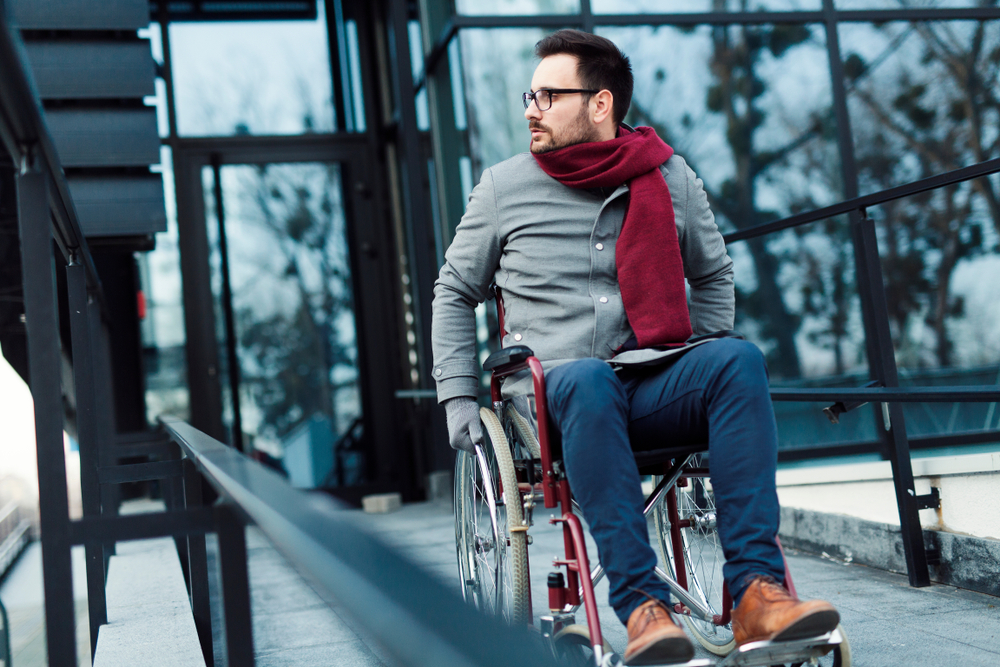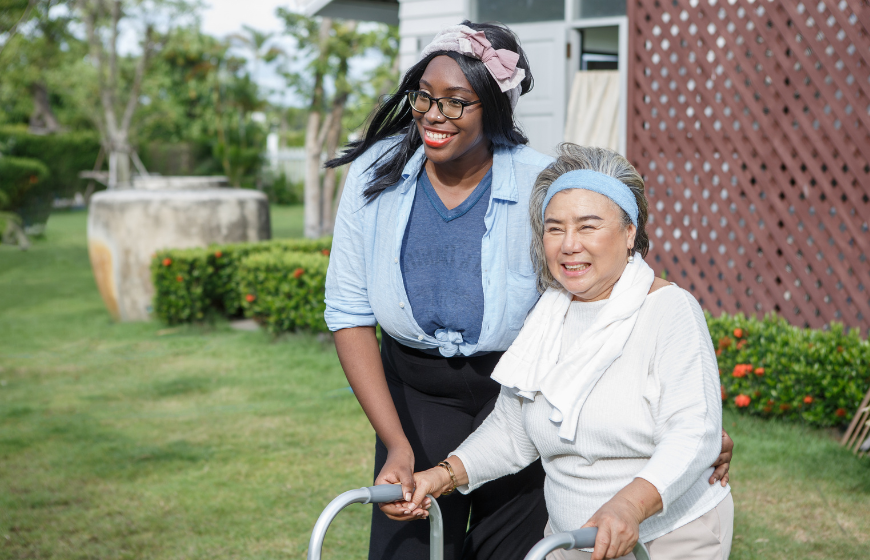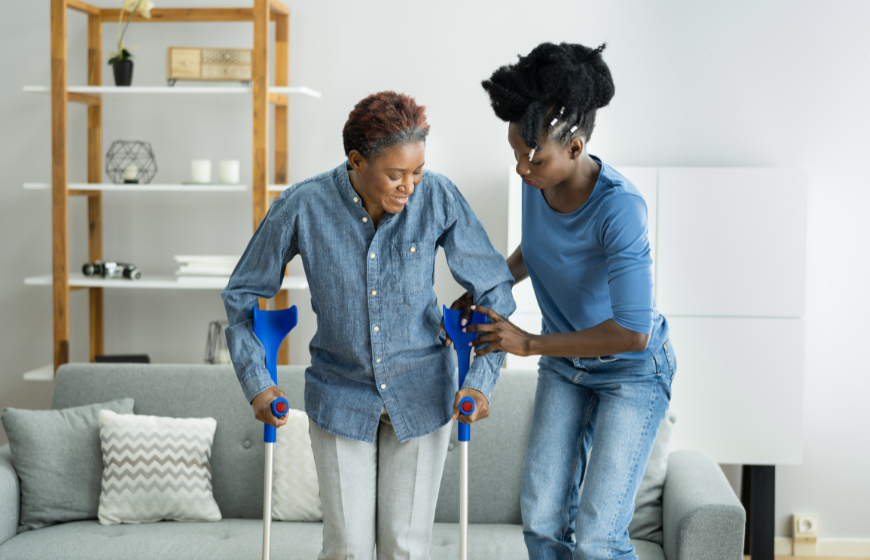Amyotrophic Lateral Sclerosis, or ALS, is a neurological condition that plagues cells in the nervous system that control our voluntary muscle movements.
Initially, ALS can present as muscle cramps or stiffness, twitching in the arms and legs, slurred speech, and difficulty swallowing. Over time, ALS worsens gradually until all voluntary movements are affected, including eating and even breathing.
While there is currently no cure for ALS, knowing the early warning signs can prepare you for the many decisions, you’ll have to make regarding your loved one’s care.
What is ALS?
ALS is one of several neuron motor diseases characterized by the gradual degeneration of the neuron motors responsible for voluntary muscle movements. Voluntary muscle movements are all the movements we choose to make, including:
- Walking
- Reaching/lifting arms
- Chewing
- Speaking
- Swallowing
Motor neurons are cells that carry messages from the brain through the spinal cord to the muscles of the body that tell them what actions you want to perform. For example, when you want to reach for something on a shelf, the command is communicated to the muscles in your arm via motor neurons.
ALS attacks those motor neurons, inhibiting their ability to send those messages. Eventually, they stop communicating with the body’s muscles, causing the muscles to weaken slowly and atrophy (or deteriorate). In the latest stages of ALS, muscles degenerate such that patients are unable to move, eat, and breathe. Most commonly, those with ALS succumb to respiratory failure, typically within three to five years of exhibiting symptoms.
ALS—also popularly known as Lou Gherig’s disease, after the famous athlete who was diagnosed in the 1940s—affects at least 30,000 people in the United States, with nearly 5,000 new cases diagnosed each year.1
What Are the Early Signs of ALS?
Although the final stages of the disease are marked by extreme weakness and functional difficulties, early ALS warning signs are more subtle.
In general, ALS symptoms first manifest in one of two ways: “limb onset” or “bulbar onset.”
Limb Onset
Limb onset is when ALS symptoms first appear in the motor functions of arms, legs, and other extremities.
Signs of limb onset ALS include:
- Twitching or spasms in the muscles of the arms, legs, or shoulders
- Muscle cramping
- Weakness in muscles of arms, legs, or diaphragm
- Spasticity or tightness and stiffness of muscles
It’s important to understand that early symptoms of ALS occur differently between patients. One person might experience difficulty writing by hand or grasping certain objects, while another might experience twitching in their legs or arms. Still, others might have trouble walking, finding themselves losing their balance, or falling.
With ALS, basic motor functions become impaired. Everyday tasks that most of us take for granted can become troublesome endeavors for those suffering from limb onset ALS symptoms. Brushing one’s teeth or buttoning one’s shirt, tying one’s shoes, or even lifting a glass of water can prove difficult.
Other limb onset ALS symptoms might read as clumsiness, for instance, tripping or dropping things. In other cases, patients might experience noticeable fatigue in the muscles of their arms and legs.
Bulbar Onset
Bulbar onset is when patients first exhibit symptoms in their ability to swallow and speak. Symptoms to look out for include:
- Slurred speech
- Nasal speech
- Difficulty chewing or swallowing
- Choking
- Weakness or twitching in facial muscles, throat, and tongue
Even earlier, patients experiencing bulbar onset symptoms might have difficulty forming words, irregular speech patterns, or horse, strained voices. They may also have trouble projecting or speaking at louder volumes.
Although ALS as a degenerative disease progresses at a different rate for each affected person, research suggests that those with bulbar onset experience a somewhat faster progression than those with limb onset symptoms.2
Causes of ALS
Like many neurological disorders, medical professionals have no definitive answer for what causes ALS or why some people develop it, and others don’t. However, research suggests that factors contributing to ALS are both genetic and environmental.
Genetics
Research has shown that certain gene mutations might contribute to the development of ALS. For example, mutations on the SOD1 gene, which controls the production of an enzyme that cells in our bodies need to break down toxic oxygen molecules, are thought to be a factor.
Gene mutations that affect how cells process RNA molecules—the molecules that help cells synthesize proteins—have also had an observable link to ALS. Likewise, genetic mutations that inhibit protein recycling have been observed.
Relatedly, age, gender, and race can play a part in who develops ASL. While the disease can strike at any age, most diagnoses occur between 55 and 75. Men are at a slightly higher risk of developing the disease, as are Caucasians and non-Hispanics.
Environmental Factors
The environmental factors that might contribute to the development of ALS remain a subject of much research in the medical community. Some of the factors thought to be linked to ALS include:
- Exposure to toxins
- Certain viruses
- Behavioral factors
- Occupational factors
- Diet
- Physical trauma
People who are regularly engaged in strenuous physical activity, such as athletes and manual laborers, are thought to be at special risk of developing ALS. Armed services veterans are likewise at risk due to toxic agents or physical trauma they may have been exposed to during their service.
Diagnosing and Treating ALS
Unfortunately, ALS can be a tricky condition to diagnose. Unlike other diseases and conditions that can be diagnosed with a single test or procedure, ALS requires a series of tests and examinations that ultimately rule out other similar conditions.
Some of the tests that are routinely administered before an ALS diagnosis include:
- Regular neurological examinations – This enables the medical professional to determine whether muscle weakness, wasting, or spasticity are worsening.
- Electromyography – This test records the electrical activity of muscles to assess their health and vitality.
- Nerve conduction study – This measures the ability of specific nerves to send messages to muscles
- Blood/urine tests – Depending on a patient’s symptoms, blood and urine tests can be administered to rule out other conditions.
- X Rays and MRIs – These provide detailed images of the brain and spinal cord.
- Muscle biopsy – A muscle biopsy can rule out other muscle diseases in specific parts of the body.
It’s important to reiterate that the variable nature of ALS, both in terms of symptoms and progression, complicates the diagnostic processes. Your loved one’s physician should conduct a thorough preliminary examination, which will enable them to decide which tests and procedures are most suited to your loved one’s specific situation.
Because several diseases and conditions carry similar symptoms as ALS, the ALS Association recommends that anyone who receives an ALS diagnosis consult an ALS expert for a second opinion.3
Treating ALS
Although there is no known treatment to cure ALS or repair damage caused by the disease, there are treatment options that can help patients manage their symptoms, prevent further complications from the disease, and improve their quality of life.
The best treatment plans for patients who have ALS are individualized and will involve the input and management of a team of healthcare professionals working in concert. Several factors that affect this plan, one of which is how far the disease has progressed. Those in the latter stages of ALS most likely need nursing support at home. Whether in the early or late stages, treatment might include:
- Medications – Medications like Riluzole, taken orally, can reduce damage to neuron motor cells, while the intravenous drug Edaravone can slow the decline of daily functionality.
- Physical and occupational therapy – Activities like walking, swimming, and stationary cycling can enhance a patient’s unaffected muscles and help them retain independence and comfort.
- Speech therapy – For patients with bulbar onset symptoms, working with a speech therapist can help slow decline in speaking and/or develop other methods of communication once those faculties begin to fail.
- Breath therapy – For patients who develop trouble breathing, regular breathing treatments known as noninvasive ventilation can be beneficial.
Choose the Best in ALS Home Care
ALS is characterized by its relatively rapid progression and its debilitating effects. As the brain’s ability to communicate with the body’s muscles deteriorates, it loses its ability to control essential motor functions. Because of how fast motor functions deteriorate, patients and their loved ones should consider the benefits of hospice care as the disease progresses.
With proper care and treatment, a percentage of patients manage to live for ten or more years from diagnosis—which is why it’s so important to know what are the first signs of ALS.
The sooner your loved one is examined and diagnosed, the sooner you can begin making plans for their care and treatment—and hopefully extend their life and maintain its quality.
Caring for a loved one with ALS is a difficult and time-consuming task. At Alliance Homecare, our extensive network of medical professionals means the help you need is always a click away. Our dedicated and specialized staff of at-home healthcare professionals can relieve the stress by managing your loved one’s healthcare needs and helping them to enjoy their life—and allowing you to enjoy it with them.
When you choose Alliance Homecare, you choose the best in ALS home care—we partner with the ALS Association to ensure your loved ones receive the most up-to-date care possible.
Sources:
- National Institute of Neurological Disorders and Stroke. ALS Fact Sheet. https://www.ninds.nih.gov/Disorders/Patient-Caregiver-Education/Fact-Sheets/Amyotrophic-Lateral-Sclerosis-ALS-Fact-Sheet
- ALS Therapy Development Institute. Limb and Bulbar Onset ALS https://www.als.net/news/science-sunday-limb-and-bulbar-onset-als/
- ALS.org. Understanding ALS. https://www.als.org/understanding-als/symptoms-diagnosis





